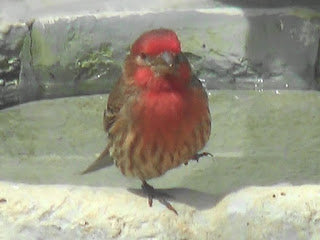We first met Mr. and Mrs. Pi on a crisp morning in March, the 14th of 2020. The air was in the low 50s (°F), and the patio was quiet save for the faint rustling of early spring. That’s when we saw them — two house finches busily at work beneath our retractable roof, weaving the foundations of a home in the corner nook of the patio.
Mr. Pi, caught red-beaked in the act, dropped a straw when he noticed me. He looked so startled — almost embarrassed — but endearingly so. Within days, they realized we meant no harm. The nest was completed with astonishing speed. Eggs were laid. Life quietly stirred. Then one day, wild little chicks emerged.
And one unforgettable moment - on April 18 - I captured a photo of a brave young finch flying the coop. He landed on the patio railing, looking around with wide eyes — wonderstruck. The world was big. So much to explore. And just like that, he took off into the yard — into life.As one brood fledged and fluttered off into the world, Mrs. Pi had already begun constructing the next nest. Mr. Pi, dutiful and proud, guided the young — now feathered and restless — on their first hops and flights. Another brood came, and then another.
As the season warmed, the Pi family shifted their nest to the opposite corner of the patio, perhaps sensing the subtle change in heat and light. I began calling it Pi Palace — their elegant little haven — when reporting to Cornell’s NestWatch.
That summer of 2020, I caught many glimpses and treasured moments:
— a radiant Mr. Pi on April 22, perched triumphantly atop our water fountain.
— Mr. Pi enjoying the yard, chest puffed and wings alert on May 31
— a tiny chick sleeping peacefully in the nest on July 29, his head barely fluffed, looking almost prehistoric when zoomed in — a little dinosaur in down.
Seasons passed. The retractable awning was eventually replaced with a beautiful pergola topped by a transparent roof. The original nesting corner was no longer usable, but the Pi family, ever resourceful, simply shifted to the remaining corner. They stayed, singing songs from our ledges.
Each fall, I would gently clean out the nests. But not in 2024. In early 2025, I noticed an old nest hanging low. Had a raccoon pulled at it? Or had the finches themselves dismantled it to make way for the new?
I left it untouched - their domain.
Then came May 8, 2025 — a fierce storm swept through with high winds and hail. Just two days later, on May 10, a magnitude 4.1 earthquake struck, its epicenter only 13 miles away. When I checked the nest on May 11, it was gone — completely blown away.
I found remnants. The fallen nest showed no eggs, just some fecal matter and an old pale blue shell — likely from the previous season. But what stunned me was the new nest I had seen earlier: a true architectural marvel. Unlike the simpler constructions from 2020, this one was built with polypropylene mesh netting — white, lightweight, water-resistant, and incredibly strong. It wasn't just insulation — it formed a structural framework around the cup of the nest. Inside, the lining was soft with fur, carefully chosen for warmth and comfort.
Mr. and Mrs. Pi and their offspring had adapted — not just surviving, but evolving, weaving human-made materials into the fabric of their home. It was a quiet testament to ingenuity and resilience, to learning over time, and to the persistence of life at the edges of our own.
What began with a startled straw-drop in 2020 became five years of quiet companionship — seasons of nests, fledglings, and shared space. Their broods grew, their brilliance shone, and their trust gently deepened.
And if you're still nearby, the original Mr. and Mrs. Pi — thank you for making our patio your home, the Pi Palace. Whether it’s you or your descendants fluttering through the garden now, your legacy lives on. In your small, determined way, you showed us how life adapts, how beauty is built from scraps, and how even the tiniest creatures can leave lasting imprints on our hearts.


